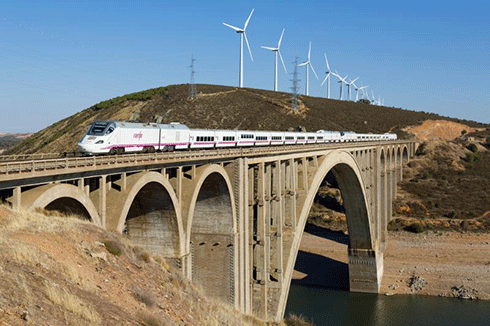
|
Published: 14 April 2014
Fast train a low emission, feasible option for east coast routes
High speed rail linking Melbourne, Sydney and Brisbane would reduce carbon emissions and provide a profitable and popular service, according to a research report released last week.

|
|
High speed rail can run on 100 per cent renewable energy. Credit:
Martin Gil/BZE
|
Climate change think tank Beyond Zero Emissions (BZE) coordinated the report. According to BZE CEO Stephen Bygrave, the research shows that high speed rail ‘can reduce greenhouse gas emissions from transport, in addition to the regional development and economic benefits previously identified’.
The report represents a two-year collaboration between BZE, the German Aerospace Centre (DLR) and the University of Melbourne’s Energy Research Institute.
It recommends an alignment broadly similar to a recent government study connecting 12 major regional towns, as well as the cities of Brisbane, the Gold Coast, Newcastle, Sydney, Canberra and Melbourne.
‘Regional travel in Australia is highly concentrated in the east coast corridor, generating some of the busiest flight paths in the world as well as significant traffic on our main interstate highways,’ says lead author, Gerard Drew.
One of the reasons Sydney Airport is facing capacity constraints is because it is shares two of the world’s busiest flight paths: Sydney-Melbourne is number five and Sydney-Brisbane is number thirteen.
‘For too long the discussion has been misled by concerns of low population density in Australia rendering HSR inappropriate for this country,’ added Drew.
‘The fact is much of Australia’s population is highly concentrated in the capital cities on the east coast and there is a high degree of travel between them by world standards.
‘All this travel is increasingly dependent on imported fossil fuels adding to Australia’s carbon footprint, and unfortunately it is doubtful that emissions-free air travel will ever eventuate.
‘High speed rail runs on electricity, which means, unlike air travel, it can run on 100 per cent renewable energy. This is the prime motivation behind BZE’s recommendation of high speed rail.
‘A high speed rail system on Australia’s east coast will reduce greenhouse gas emissions from regional travel in this busy corridor by almost 30 per cent.
‘On top of this high speed rail will continue to provide affordable, convenient and comfortable travel for Australians into the future without the uncertainty of fuel supply and price.’
The report found that:
-
High speed rail ticketing revenue could not only cover operational costs but also repay construction costs
-
60 per cent of Australia's population live within 50 km of a proposed high speed rail station
-
Comparable high speed rail projects around the world have been built in ten years or less
-
Greenhouse emissions from transport would be reduced by 150 million tonnes of carbon dioxide equivalent over 40 years of operation.
Source: BZE



